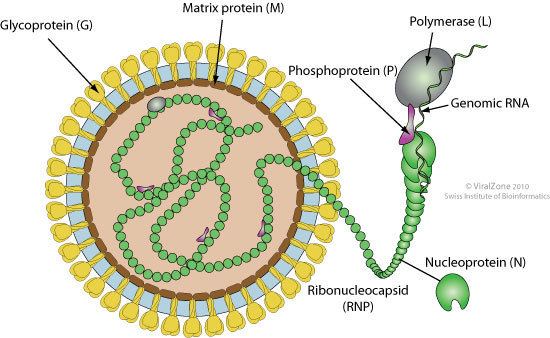Group Group V ((-)ssRNA) Genus Bornavirus | Scientific name Bornaviridae Rank Family | |
 | ||
Similar Borna disease v, Mononegavirales, Tetraviridae, Ophioviridae, Corticovirus | ||
Bornaviridae is a family of viruses in the order Mononegavirales. Horses, sheep, cattle, rodents, birds, and humans serve as natural hosts. Currently, seven species are included in one genus in this family. Diseases associated with bornaviruses include Borna disease, a fatal neurologic disease of mammals restricted to central Europe; and proventricular dilatation disease in birds.
Contents
Taxonomy
Table legend: "*" denotes type species.
Structure
Bornavirions are enveloped, with spherical geometries. The diameter is around 70 to 130 nm. Genomes are linear, around 8.9kb in length. The genome codes for 9 proteins.
Life cycle
Viral replication is nuclear. Entry into the host cell is achieved by attachment of the viral GP glycoproteins to host receptors, which mediates clathrin-mediated endocytosis. Replication follows the negative stranded RNA virus replication model. Negative stranded RNA virus transcription, using polymerase stuttering, with some alternative splicing mechanism, is the method of transcription. The virus exits the host cell by nuclear pore export. Horses, sheep, cattle, rodents, birds, and humans serve as the natural hosts. Transmission routes are fomite, contact, urine, feces, and saliva.
Pathogenicity
Between 2011 and 2013, three German breeders of variegated squirrels (Sciurus variegatoides) had encephalitis with similar clinical signs and died 2 to 4 months after onset of the clinical symptoms. Genomic analysis found a previously unknown bornavirus in a contact squirrel and in brain tissue from the three men, the researchers reported, and it is the "likely causative agent" in their deaths. Prior to this, Bornavirus species were not thought to be responsible for human diseases.
